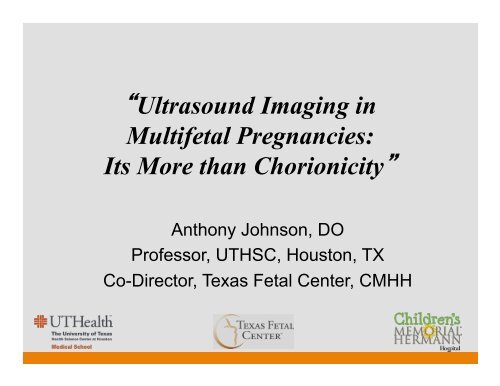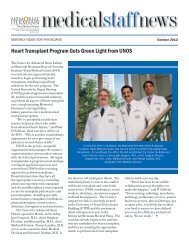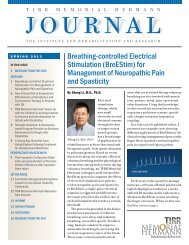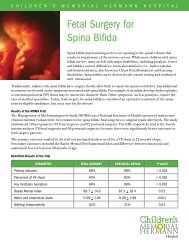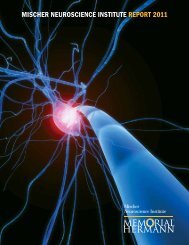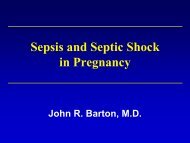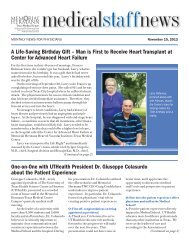Ultrasound Imaging in Multifetal Pregnancies: Its
Ultrasound Imaging in Multifetal Pregnancies: Its
Ultrasound Imaging in Multifetal Pregnancies: Its
You also want an ePaper? Increase the reach of your titles
YUMPU automatically turns print PDFs into web optimized ePapers that Google loves.
“<strong>Ultrasound</strong> <strong>Imag<strong>in</strong>g</strong> <strong>in</strong><br />
<strong>Multifetal</strong> <strong>Pregnancies</strong>:<br />
<strong>Its</strong> More than Chorionicity”<br />
Anthony Johnson, DO<br />
Professor, UTHSC, Houston, TX<br />
Co-Director, Texas Fetal Center, CMHH<br />
1
Disclosures<br />
• I have no relationships with commercial companies<br />
that could be perceived as a conflict of <strong>in</strong>terest.<br />
• I will not be discuss<strong>in</strong>g the use of products that are<br />
<strong>in</strong>vestigational or approved devices that are be<strong>in</strong>g<br />
used “off label”
Per<strong>in</strong>atal mortality<br />
MC vs. DC tw<strong>in</strong>s<br />
Dutch cohort study 1995-2004<br />
Outcome<br />
Per<strong>in</strong>atal<br />
Mortality<br />
MC<br />
(n = 198)<br />
DC<br />
(1107)<br />
Hazard Risk<br />
(95%CI)<br />
11.6% 5.0% 2.44<br />
(1.73-3.44)<br />
Stillbirth 7.6% 1.5% 5.21<br />
(3.18-8.51)<br />
Screen<strong>in</strong>g protocol:<br />
- 1 st trimester ultrasound for chorionicity<br />
- 20 wks anatomic survey<br />
- Serial ultrasounds (fortnightly) for growth, AFV and Doppler assessment<br />
Hack KEA et al BJOG 2008;115:58-67
Outcome of MCDA tw<strong>in</strong> gestations <strong>in</strong> the<br />
era of <strong>in</strong>vasive fetal therapy<br />
Survival<br />
Tw<strong>in</strong> live births 172 85%<br />
S<strong>in</strong>gleton 15 7%<br />
Double demise 15 7%<br />
Complication<br />
TTTS 18 9%<br />
sIUGR 30 15%<br />
Losses<br />
Total 11% (TTTS ~ 42%)<br />
< 24 weeks 84%<br />
> 24 weeks 16%<br />
> 32 weeks 1%<br />
Extra loss <strong>in</strong> MC tw<strong>in</strong>s is due to complications placental anastomoses<br />
Lewi et al., 2008
Complications <strong>in</strong> Monochorionic<br />
Multi-Fetal <strong>Pregnancies</strong><br />
• Tw<strong>in</strong>-Tw<strong>in</strong> Transfusion Syndrome<br />
- Oligo/Polyhydramnios Sequence ~ TOPS<br />
- Tw<strong>in</strong> Anemia Polycythemia Sequence ~ TAPS<br />
• Tw<strong>in</strong> Reverse Arterial Perfusion<br />
• Growth Discordance<br />
• Discordant malformations<br />
- Structural<br />
- Chromosomal<br />
• Monoamnioitc
Diagnosis
"There is NO diagnosis of tw<strong>in</strong>s.”<br />
“The only diagnosis is a monochorionic or<br />
dichorionic tw<strong>in</strong> gestation.<br />
This should be written <strong>in</strong> capital red letters<br />
on the front of the chart at 8 - 10 weeks".<br />
K Nicolaides, 02/27/09
<strong>Multifetal</strong> <strong>Pregnancies</strong><br />
<strong>Ultrasound</strong> Determ<strong>in</strong>ation of<br />
Amnionicity & Chorionicity<br />
1 st Trimester <strong>Ultrasound</strong> Exam<strong>in</strong>ation:<br />
- Amnionicity and chorionicity should be documented for all<br />
multiple gestations when possible.<br />
2 nd & 3 rd Trimester <strong>Ultrasound</strong> Exam<strong>in</strong>ation:<br />
- Multiple gestations require the documentation of additional<br />
<strong>in</strong>formation: chorionicity, amnionicity, comparison of fetal<br />
sizes, estimation of amniotic fluid volume on each side of<br />
the membrane, and fetal genitalia (when visualized).<br />
AIUM PRACTICE GUIDELINES, Oct 2007<br />
ACOG PRACTICE GUIDELINES, #101, Reaffirmed 2011
<strong>Ultrasound</strong> techniques for determ<strong>in</strong><strong>in</strong>g<br />
chorionicity & amnionicity<br />
Umbilical cord entanglement<br />
Fetal sex<br />
Separate placental discs<br />
No. of layers <strong>in</strong> membrane<br />
Membrane thickness<br />
Lambda or Tw<strong>in</strong> Peaks or T-sign<br />
No. of yolk sacs<br />
No. of gestational sacs<br />
amnionicity<br />
chorionicity<br />
First trimester Second Trimester Third Trimester<br />
J Rob<strong>in</strong>son & AZ Abuhamad Modern Medic<strong>in</strong>e 2002
<strong>Multifetal</strong> <strong>Pregnancies</strong><br />
Chorionicity<br />
Monochorionic<br />
“T” sign<br />
Dichorionic<br />
Lambda or Tw<strong>in</strong> Peak sign<br />
Moise KJ Texas Medic<strong>in</strong>e 2007
<strong>Multifetal</strong> <strong>Pregnancies</strong> ~ Establish chorionicity<br />
10 - 14 weeks<br />
“T” sign<br />
Monochorionic<br />
Tw<strong>in</strong> Peak (lambda)<br />
Dichorionic
Accuracy of Ultrasonographic<br />
Chorionicity Classification*<br />
Pathologic Evaluation<br />
Misclassification<br />
Total 545 6.4%<br />
Dichorionic 455 4%<br />
Monochorionic 90 19%<br />
*Classified by ultrasound < 20 weeks<br />
Sensitivity Specificity PPV NPV<br />
96% 81% 96% 80%<br />
< 14 wks vs. 15-20 wks<br />
Odds Ratio: 0.47; 95% CI 0.23, 0.96<br />
58% ACOG optimal time for Dx chorionicity 1 st trimester<br />
62% Manage all tw<strong>in</strong>s without MFM consultation<br />
Blumenfeld Y AIUM 2013; Cleary-Goldman J et al 2004
Accuracy of referral vs. tertiary diagnosis of<br />
amnionicity and chorionicity<br />
Tw<strong>in</strong>s<br />
DADC<br />
DAMC<br />
MOMO<br />
Triplets<br />
TATC<br />
TADC<br />
TAMC<br />
Center DADC DAMC MOMO Total<br />
Referr<strong>in</strong>g<br />
Tertiary<br />
Referr<strong>in</strong>g<br />
Tertiary<br />
Referr<strong>in</strong>g<br />
Tertiary<br />
Referr<strong>in</strong>g<br />
Tertiary<br />
Referr<strong>in</strong>g<br />
Tertiary<br />
Referr<strong>in</strong>g<br />
Tertiary<br />
45%<br />
98%<br />
28%<br />
96%<br />
49%<br />
96%<br />
24%<br />
92%<br />
50%<br />
83%<br />
0<br />
100%<br />
83<br />
167<br />
40<br />
72<br />
8<br />
5<br />
8<br />
25<br />
4<br />
13<br />
1<br />
1<br />
Accurate diagnosis of A/C can be obta<strong>in</strong>ed by assessment of key sonographic f<strong>in</strong>d<strong>in</strong>gs<br />
Emphasis on need to enhance diagnostic skills <strong>in</strong> the general community & referral if dx ambiguous<br />
Wan JJ et al Prenat Diagn 2011
Take home message<br />
Two is better than one !!
Bipartite Monochorionic<br />
Placentation<br />
• Tw<strong>in</strong> <strong>Pregnancies</strong> with two<br />
separate placental masses can<br />
still be monochorionic and have<br />
vascular anastomoses<br />
• Lopriore E, et al 2006 ~ 3/109<br />
• Mach<strong>in</strong> GA et al 2002 ~ 8/600<br />
If is looks like TTTS ~ it is until proven otherwise
Monozygotic Tw<strong>in</strong>s<br />
Incidence of Anomalies<br />
– 845 pairs of tw<strong>in</strong>s w/evaluation of zygosity:<br />
• 483 monozygotic<br />
• 252 dizygotic<br />
• 110 zygosity unconfirmed<br />
– Anomalies:<br />
• MZ: 2.7% (82% discordant)<br />
• DZ: 1% (100% discordant)<br />
• S<strong>in</strong>gletons: 0.6%<br />
Chen et al. Acta Genet Med Gememol 1992;41:197-203
Bahityar MO, J <strong>Ultrasound</strong> Med 2007;26:1491
Monochorionic Tw<strong>in</strong>s<br />
Management of Anomalies<br />
Risk of death or longterm compromise co-tw<strong>in</strong><br />
• Old theory of “bad humors’ cross<strong>in</strong>g to the live tw<strong>in</strong><br />
discounted<br />
• Acute hemodynamic changes the more likely etiology<br />
• No benefit from acute delivery<br />
• 15% of cases associated with IUFD of co-tw<strong>in</strong><br />
– ↑ 5X over dichorionic tw<strong>in</strong>s<br />
• 34% abnormal postnatal cranial imag<strong>in</strong>e with IUFD co-tw<strong>in</strong><br />
• 26% of survivors with neurologic sequelae<br />
– ↑ 12X over dichorionic tw<strong>in</strong>s<br />
Fusi et al. Obstet Gynecol 1991;78:517-20<br />
Ong et al. BJOG 2006;113:992-8<br />
Hillman et al Obstet Gynecol 2011;118:928-40
Maternal-Fetal Surgery: Balanc<strong>in</strong>g Risks<br />
Discordant Fetal Malformation<br />
<strong>Multifetal</strong> Gestations<br />
Observation<br />
Intervention
Per<strong>in</strong>atal Outcomes of Tw<strong>in</strong> <strong>Pregnancies</strong><br />
Discordant for Major Fetal Anomalies<br />
Category Normal Tw<strong>in</strong>s Discordant<br />
Tw<strong>in</strong>s*<br />
Number 235 13<br />
GA_Delivery 34<br />
(16-40)<br />
Birth Weight 2030<br />
(180 – 3680)<br />
Per<strong>in</strong>atal<br />
Survival<br />
*2/3 cotw<strong>in</strong> <strong>in</strong> MCDA set end as IUFD<br />
32<br />
(24-37)<br />
1640<br />
(520-3320)<br />
P<br />
0.029<br />
0.022<br />
91% 69% 0.018<br />
Gul A et al, Fetal Diagno Ther 2005;20:244
Dilemmas <strong>in</strong> Management of tw<strong>in</strong>s discordant<br />
for anencephaly diagnosed at 11-14 weeks<br />
Chorionicity # Hydramnios Livebirth GA<br />
Delivery<br />
Delivery<br />
< 33 wks<br />
DICHORIONIC<br />
Expectant Obs<br />
Reduction<br />
35<br />
9<br />
57%<br />
0<br />
97%<br />
89%<br />
36<br />
37<br />
18%<br />
13%<br />
Monochorionic<br />
Expectant Obs 19 52% 84%* 33 38%<br />
MC Intervention<br />
Laser coagulation<br />
Cord Ligation<br />
Bipolar<br />
6<br />
24<br />
92<br />
100%<br />
54%<br />
77%<br />
33%<br />
69%<br />
31%<br />
* IUFD of affected Tw<strong>in</strong> with co-tw<strong>in</strong> demise <strong>in</strong> 3/4<br />
Vandecruys H <strong>Ultrasound</strong> Obstet Gynecol 2006;28:653
Acardiac Tw<strong>in</strong><br />
Incidence 1/35,000<br />
Earliest form of TTTS<br />
Reverse Arterial Perfusion ~‘acardiac”<br />
Co-tw<strong>in</strong> anomaly ~ 10%<br />
Per<strong>in</strong>atal M&M ~ 50%<br />
Growth AT:PUMP 70%<br />
Polyhydramnios<br />
Cardiac decompensation <strong>in</strong> pump tw<strong>in</strong>
Acardiac Tw<strong>in</strong>
Acardiac Tw<strong>in</strong>
Outcome <strong>in</strong> TRAP <strong>Pregnancies</strong><br />
Observation vs. Intervention<br />
Acardiac size < 50% of Pump<br />
Group N Acardiac<br />
Size<br />
MOMO<br />
Pump<br />
Survival<br />
GA<br />
Delivery<br />
Observation 8 27% 38% 88% 34<br />
Intervention<br />
(RFA)<br />
7 49% 0% 100% 36<br />
Jel<strong>in</strong> E et al Fetal Diagn Therp 2010:27;138
Outcome of TRAP sequence diagnosed <strong>in</strong> the<br />
IUFD of<br />
pump tw<strong>in</strong>, 33%<br />
first trimester<br />
Survival Rate<br />
1 st Tri DX<br />
46% 11/24<br />
Arrest of Flow<br />
Acardiac, 24%<br />
3/5 Pump tw<strong>in</strong>s<br />
Demise or Abnl CNS<br />
Follow<strong>in</strong>g arrest<br />
of flow to acardiac<br />
Pump alive Flow<br />
In Acardiac, 46%<br />
Intervention need<br />
12-16 weeks<br />
Liesbeth L et al, AJOG, 2010; 203,213.e1 - 213.e4
Tw<strong>in</strong>-tw<strong>in</strong><br />
Transfusion<br />
Syndrome
Monochorionic Tw<strong>in</strong>s<br />
Epidemiology of TTTS<br />
• Complicates 9 – 15% of MCDA tw<strong>in</strong>s<br />
• 1 <strong>in</strong> 58 tw<strong>in</strong> pregnancies<br />
• 1 <strong>in</strong> 4,170 pregnancies<br />
• Presentation < 26 weeks ~ 90% per<strong>in</strong>atal mortality<br />
Dick<strong>in</strong>son et al. Am J Obstet Gynecol 2000;182:706-12<br />
Saunders et al. Am J Obstet Gynecol 1992;166:820-4
Tw<strong>in</strong> Tw<strong>in</strong> Transfusion<br />
Syndrome Diagnosis<br />
S<strong>in</strong>gle placenta<br />
Polyhydramnios (8cm) / oligohydramnios (2cm)<br />
Concordant for sex<br />
Discordant for size and placental echogenicity<br />
Recipient persistent enlarged bladder<br />
Donor small or non-visible bladder
Prediction of Tw<strong>in</strong> Tw<strong>in</strong> Transfusion<br />
Nuchal Translucency<br />
Fold<strong>in</strong>g Intertw<strong>in</strong> Membrane<br />
Arterio-arterial anastomoses<br />
Discordant AFV*<br />
*Sueters M et al <strong>Ultrasound</strong> Obstet Gynecol. 2006 Oct;28(5):659-64
Tw<strong>in</strong>-Tw<strong>in</strong> Transfusion Syndrome Stag<strong>in</strong>g<br />
(TOPS)<br />
Stage I<br />
Stage II<br />
Stage III<br />
Stage IV<br />
Oligohydramnios(8cm)<br />
Discordant fluid volume<br />
No bladder <strong>in</strong> the donor tw<strong>in</strong><br />
Doppler flow- absent or reversed <strong>in</strong> umbilical artery or<br />
ductus venosus, pulsatile flow <strong>in</strong> the umbilical ve<strong>in</strong><br />
Hydrops <strong>in</strong> one or both fetuses<br />
Stage V<br />
One or both fetuses have died<br />
Qu<strong>in</strong>tero R et al J. Per<strong>in</strong>atol 1999;19:55
Qu<strong>in</strong>tero Stage Related Outcomes <strong>in</strong> TTT<br />
Follow<strong>in</strong>g Laser Photocoagulation<br />
Report N I II III IV<br />
Qu<strong>in</strong>tero, 2003<br />
Both<br />
95<br />
67%<br />
49%<br />
25%<br />
46%<br />
> 1<br />
86%<br />
86%<br />
79%<br />
82%<br />
Huber, 2006<br />
Both<br />
200<br />
76%<br />
61%<br />
54%<br />
50%<br />
> 1<br />
93%<br />
83%<br />
83%<br />
70%
Suspected TTTS<br />
How often Dx Correct & Referral Timely<br />
N %<br />
Confirmed Dx TTTS 249 77%<br />
Stage<br />
1<br />
2<br />
3<br />
4<br />
5<br />
28<br />
50<br />
150<br />
15<br />
10<br />
11%<br />
20%<br />
60%<br />
6%<br />
4%<br />
No TTTS 75 23%<br />
Discordant AFV<br />
sIUGR<br />
42<br />
33<br />
56%<br />
44%<br />
Gandhi M et al, 2012
Tw<strong>in</strong> Anemia-Polycythemia Sequence<br />
(TAPS)<br />
• Larger <strong>in</strong>tertw<strong>in</strong> hemoglob<strong>in</strong> difference w/o signs of<br />
TOPS<br />
• Intertw<strong>in</strong> blood transfusion w/o hormonal<br />
imbalance<br />
• Post laser: ex-recipient anemic w/ ex-donor<br />
polycythemic ~ 77%<br />
• Spontaneous reported as early as 16 weeks<br />
Study N Post-laser<br />
Robyr, 2006 101 13%<br />
Habli, 2009 152 2%<br />
Slagehekke,2010 276 8%<br />
Spontaneous*<br />
Lewi et al, 2009 202 5%<br />
Lopriore, 2010 113 5%<br />
Slagehekke F et al Fetal Diagn Therapy 2010
TAPS<br />
Optimal Management is Unclear<br />
• Expectant observation<br />
• Induction of labor<br />
• Selective reduction<br />
• Laser photocoagulation<br />
• Intrauter<strong>in</strong>e transfusion<br />
Intravascular/<strong>in</strong>traperitoneal<br />
IV / exchange transfusion<br />
• Per<strong>in</strong>atal mortality and<br />
morbidity unknown<br />
• Majority Dual Survivors<br />
• IUFD (dual & s<strong>in</strong>gle)<br />
• Thrombosis, CNS<br />
Infarct; Hydrops<br />
Delivery 32 wks 4 days<br />
Dual survivors<br />
S<strong>in</strong>gle AA at placental edge<br />
Herway C et al <strong>Ultrasound</strong> Obstet Gynecol 2009;33:592
Vascular Occlusion Injuries <strong>in</strong> TTTS<br />
• 95% recipient<br />
• 85% lower limb<br />
• 71% right sided<br />
• Intest<strong>in</strong>al atresia<br />
• Mechanism<br />
• Polycythemia<br />
• Hyperviscosity<br />
• Hypertension<br />
• Vascoconstriction<br />
Schrey S et al AJOG 2012
Discordant Growth & Selective IUGR
Discordant Growth <strong>in</strong> Tw<strong>in</strong> <strong>Pregnancies</strong><br />
Associated Outcomes<br />
• Anomalies<br />
• IUGR<br />
• Preterm Birth<br />
• Intrauter<strong>in</strong>e <strong>in</strong>fection<br />
• Stillbirth<br />
• UA cord ph < 7.10<br />
• NICU Admission<br />
• RDS<br />
• Neonatal Death<br />
Debate<br />
• Detection efficacy<br />
• Significant threshold<br />
• Co-morbidities<br />
• Management strategy<br />
ACOG Practice Bullet<strong>in</strong> #56, reaffirmed 2009
Factors Affect<strong>in</strong>g Fetal<br />
Maternal<br />
Placental*<br />
Fetal<br />
Growth Discordance<br />
• Tobacco<br />
• Vascular disease<br />
• Poor prenatal care<br />
• Low Maternal wt ga<strong>in</strong><br />
• Vascular anastomoses<br />
• Placental shar<strong>in</strong>g<br />
• Placental weight<br />
• Velamentous <strong>in</strong>sertion<br />
• Aneuploidy<br />
• Sex-discordance<br />
• Viral Infection<br />
* Major component of discordance <strong>in</strong> MC tw<strong>in</strong>n<strong>in</strong>g
Def<strong>in</strong>ition & Impact of Discordant<br />
Fetal Growth <strong>in</strong> MC Tw<strong>in</strong>s<br />
Discordant growth = selective growth restriction<br />
• Discordant Growth<br />
- (Largest – Smallest) / Largest * 100<br />
- EFW or birthweight<br />
- ACOG def<strong>in</strong>es discordance 15-25%<br />
- SOGC – > 20% EFW or [AC large – AC small] > 20 mm<br />
31 publications > 1.1 million tw<strong>in</strong>s<br />
16% discordance<br />
137,000 US tw<strong>in</strong> births/yr<br />
22,000 discordant tw<strong>in</strong>s/yr<br />
Mart<strong>in</strong> JA CDC NCHS data brief 80;2012<br />
Miller J et al AJOG 2012:206;10
First trimester prediction<br />
Tw<strong>in</strong> complications & adverse outcome<br />
Study # Placenta Bwt<br />
> 20%<br />
sIUGR<br />
Early<br />
IUFD<br />
Per<strong>in</strong>atal<br />
Mortality<br />
Sebire, 1998 549 MC/DC - - + -<br />
Kalish, 2004 159 DC + - + -<br />
Tai, 2007 178 MC/DC + - - -<br />
Banks, 2008 135 DC - - - -<br />
Memmo, 2011 242 MC +<br />
D’Antonio, 2013 2155 MC/DC - - - -<br />
In the absence of aneuploidy or structural malformations CRL discordance<br />
is a poor predictor for adverse per<strong>in</strong>atal outcome <strong>in</strong> MC and DC tw<strong>in</strong> pregnancies<br />
D’Antonio F, <strong>Ultrasound</strong> Obstet Gynecol.2013; Feb 14. doi: 10.1002/uog.12430
Discordant Growth <strong>in</strong> Tw<strong>in</strong> <strong>Pregnancies</strong><br />
2 nd Trimester <strong>Ultrasound</strong> Predictive Accuracy<br />
Discordance > 20%<br />
Screen<strong>in</strong>g Test Sensitivity Specificity<br />
AC 65-83% 65-90%<br />
EFW 50-93% 80-93%<br />
Miller J et al AJOG. 2012;206:10-20
Discordance & Adverse Outcome by Chorionicity<br />
DC 18% discordance =<br />
Uncomplicated MC<br />
MC 18% discordance<br />
double risk of adverse outcome<br />
SGA 5%<br />
18% BW<br />
Discordance<br />
Choriionicity HR (95% CI) P HR (95% CI) P<br />
Monochorionic 2.6 (1.4-4.7)
Cl<strong>in</strong>ical<br />
MCDA Discordant Growth*<br />
Early<br />
(15)<br />
Late<br />
(13)<br />
Discordance EFW > 20% < 20 wks > 26 wks<br />
Concordant<br />
(150)<br />
UA Doppler abnl 73% 0 3%<br />
IUFD 27% 8% 1%<br />
TAPS 0 38% 3%<br />
GA_Delivery 33 35 35<br />
Birthwt discordance 30% 31% 9%<br />
Overall Survival Rate 83% 96% 99%<br />
Placenta<br />
Placenta Territory ratio 2.55 1.6 1.4<br />
Total Anastomotic<br />
Diameter (mm)<br />
* Bwt Discordance > 25%<br />
14 6 9<br />
Lewi L AJOG 2008;199:511.e1
Monochorionic Tw<strong>in</strong>s<br />
Selective IUGR<br />
• 10-15% of monochorionic tw<strong>in</strong>s<br />
• Smaller tw<strong>in</strong> EFW < 10%tile for gestational age<br />
• Unequal placental shar<strong>in</strong>g<br />
• +/- Unbalanced <strong>in</strong>tertw<strong>in</strong> vascular flow<br />
• Per<strong>in</strong>atal mortality & long term morbidity<br />
- Smaller tw<strong>in</strong>: IUFD 30-40% Neurologic 15-40%<br />
- Cotw<strong>in</strong> tw<strong>in</strong>: IUFD 25-30% Neurologic 20-30%<br />
- iatrogenic prematurity<br />
- acute feto-feto transfusion
Monochorionic Tw<strong>in</strong>s<br />
Classification sIUGR<br />
Type<br />
Umbilical<br />
Artery<br />
IUFD<br />
Neurologic<br />
Compromise<br />
In Utero<br />
Deterioration<br />
GA<br />
Delivery<br />
I Normal 2-4%
Per<strong>in</strong>atal outcome with expectant observation <strong>in</strong><br />
sIUGR by Umbilical Artery Doppler Classification<br />
100<br />
90<br />
80<br />
70<br />
60<br />
50<br />
40<br />
30<br />
20<br />
10<br />
0<br />
96%<br />
2%<br />
2%<br />
33%<br />
26%<br />
41%<br />
38%<br />
23%<br />
38%<br />
Intact<br />
Survivors<br />
Both<br />
One<br />
None<br />
Type I Type II Type III<br />
(23) (27) (13)<br />
Ishii K et al Fetal Diagn Ther 2009;26:157
Monochorionic Tw<strong>in</strong>s<br />
Selective IUGR<br />
Expectant Observation<br />
• Fetal monitor<strong>in</strong>g<br />
- Biophysical profile<br />
- Ductus venosus Doppler blood flow studies <strong>in</strong> Type II<br />
• Early delivery<br />
• Selective reduction<br />
• Laser ablation placental anastomoses ~ RCT
Monochorionic Diamniotic Tw<strong>in</strong>s<br />
Frequency of <strong>Ultrasound</strong> Evaluations<br />
• Serial sonographic evaluations every 2 weeks, beg<strong>in</strong>n<strong>in</strong>g at<br />
16 weeks, until delivery, should be considered for all tw<strong>in</strong>s<br />
with MCDA placentation<br />
• Screen<strong>in</strong>g for congenital heart disease is warranted <strong>in</strong> all<br />
MC tw<strong>in</strong>s, <strong>in</strong> particular those complicated with TTTS<br />
SMFM Committee Op<strong>in</strong>ion<br />
Am J Obstet Gynecol. 2013;208(1):3-18
Two Step Screen<strong>in</strong>g Strategy for<br />
Complicated Outcomes <strong>in</strong> MC Tw<strong>in</strong>s<br />
Lewi L et al Am J Obstet Gynecol 2008;199:511.e1-7
Tw<strong>in</strong>s <strong>Ultrasound</strong> Surveillance<br />
All tw<strong>in</strong>s<br />
- <strong>Ultrasound</strong> for anomalies at 18 – 20 weeks<br />
- Placental Cord Insertions<br />
- Weekly Biophysical profile > 32 weeks<br />
Dichorionic<br />
- <strong>Ultrasound</strong>s Q 4 weeks for serial growth<br />
- Change <strong>in</strong> AFV and Doppler UA may precede discordant growth<br />
Monochorionic tw<strong>in</strong>s<br />
- <strong>Ultrasound</strong>s alternate limited and growth, Q 2 weeks, 16 wks<br />
- Amniotic fluid volume, bladder<br />
- Fetal growth<br />
- Doppler blood flow studies<br />
- UA, UV, DV and MCA basel<strong>in</strong>e 20 weeks<br />
- Repeat if > 20% discordance with smaller < 10%<br />
- Uncomplicated or late discordance MCA<br />
- Fetal echocardiography
Conclusion<br />
Increase awareness of risks associated with MC pregnancies by<br />
healthcare providers and patients<br />
– “No Dx Tw<strong>in</strong>s”<br />
• Establish chorionicity early<br />
• Risk stratify multifetal pregnancies DC vs. MC<br />
– MC pregnancies serial ultrasound beg<strong>in</strong>n<strong>in</strong>g at 16 weeks<br />
• Limited (MVP, UA and bladder)<br />
• Growth studies with Doppler assessment<br />
– MFM/Fetal Treatment Center referral consultation for<br />
• Targeted ultrasound/echo<br />
• Signs of discordance growth or AFV<br />
Update ACOG Practice Bullet<strong>in</strong> #56 October, Multiple Gestation:<br />
Complicated Tw<strong>in</strong>s, Triplets and High-Order <strong>Multifetal</strong> Pregnancy<br />
5<br />
3


